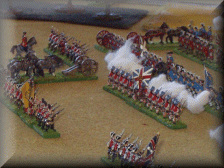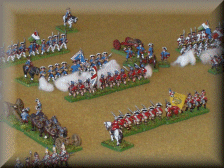Welcome
to Warfare in the 18th Century
Gaming
the Seven Years War
by
John Jenkins
Back
in July 2003 Herbert Wong and I played a 15mm French, British, Seven Years
War game using the Age of Reason
rules. The scenario was a simple
introductory encounter game with both sides equal at 10 SP (strength
points). This gives each side
between 3-4 Brigades. The game
is basically card driven with each card activating a particular brigade.
 Set
up is simultaneous, with both sides already having made a note of deployment
on paper. The set up zone for
both armies for an encounter game is 12" from the baseline and 18"
in from both sides. The narrow
deployment area means some consideration for manoeuvre to cover the flanks
must be made. The French set up
in a classical formation for the period, Infantry in strength in the centre
with cavalry on both wings. Since
the French had this advantage in cavalry, it was up to the British to secure
their flanks. The British left
flank, held a defensive position using the river as a defensive anchor,
against the threat of 2 French cavalry regiments. The British right was more
open with no terrain to anchor the wing and not enough troops to extend the
line. Set
up is simultaneous, with both sides already having made a note of deployment
on paper. The set up zone for
both armies for an encounter game is 12" from the baseline and 18"
in from both sides. The narrow
deployment area means some consideration for manoeuvre to cover the flanks
must be made. The French set up
in a classical formation for the period, Infantry in strength in the centre
with cavalry on both wings. Since
the French had this advantage in cavalry, it was up to the British to secure
their flanks. The British left
flank, held a defensive position using the river as a defensive anchor,
against the threat of 2 French cavalry regiments. The British right was more
open with no terrain to anchor the wing and not enough troops to extend the
line.
 The
French general sensing this was the weak point sent 2 regiments of Dragoons
to take advantage of the situation. The
Dragoons almost caught the British line out of position but the outer
supporting regiment managed to wheel in time and send a volley of musket
fire into the charging Dragoons at point blank range! This
was enough to rout the French Dragoons from the battlefield. In
later turns the British cavalry reserve advanced and also routed the second
French cavalry unit, securing the flank against further intrusions. Meanwhile
the centres of both armies advanced and proceeded to hammer away at each
other. The
French general sensing this was the weak point sent 2 regiments of Dragoons
to take advantage of the situation. The
Dragoons almost caught the British line out of position but the outer
supporting regiment managed to wheel in time and send a volley of musket
fire into the charging Dragoons at point blank range! This
was enough to rout the French Dragoons from the battlefield. In
later turns the British cavalry reserve advanced and also routed the second
French cavalry unit, securing the flank against further intrusions. Meanwhile
the centres of both armies advanced and proceeded to hammer away at each
other.
 Both
sides reached 25% casualties after a few turns of continuous volley fire
without any significant breakthrough in the centre, although the French
seemed to be gaining the upper hand. The
percentage of casualties initiates a 'withdrawal check'. Unfortunately
the French, failed their check and were forced to withdraw, much to the
relief of the British centre that looked like it would not survive another
round of volley fire. Both
sides reached 25% casualties after a few turns of continuous volley fire
without any significant breakthrough in the centre, although the French
seemed to be gaining the upper hand. The
percentage of casualties initiates a 'withdrawal check'. Unfortunately
the French, failed their check and were forced to withdraw, much to the
relief of the British centre that looked like it would not survive another
round of volley fire.
This
was a good example of a fairly simple encounter game for this period. A
chance for both players to try out the mechanics and familiarise themselves
with the basic rules. The choice
in this case was Warfare in the Age of Reason rules by Emperor's
Press (no longer print but readily available on the Internet). The
governing factor for a scenario like this was simply to use whatever troops
were available, to create two equal forces. 10
SP (strength points) seems to be recommended to give a good sized game which
lasts between 2-4 hours. The rules include some generic army lists so that
'equal points' armies can be fielded, and also a simple system for
generating a terrain map.
One
of the problems with encounter games, although fun is that fairly quickly
once we start reading military history, we realise that very few battles
were actually fought with equal sides. Sometimes
one force has to be the defender, and the other the attacker, also equality
of numbers and army structures can differ greatly.
An obvious approach is to attempt to reproduce historical battles or
parts of historical battles with exactly original forces, set up and
terrain. I hope in future
articles and games to reproduce some of the smaller battles of the period,
such as the Battle of Quebec, and Broglie's attack as part of the Battle of
Minden.
For
now here are some pictures of some of my 15mm French army, figures by
Essex
. To
be followed shortly by some pictures of Herbert Wong's Prussians.
There
are also plans to game the French and Indian War, in 28mm using the highly
recommended Brother v Brother rules.
Watch out for a series of articles on simple skirmish scenarios for
this period. Just to whet the
appetite some pictures of 28mm Front Rank's F & I War range that are on
the painting table!

back to seven years war
|